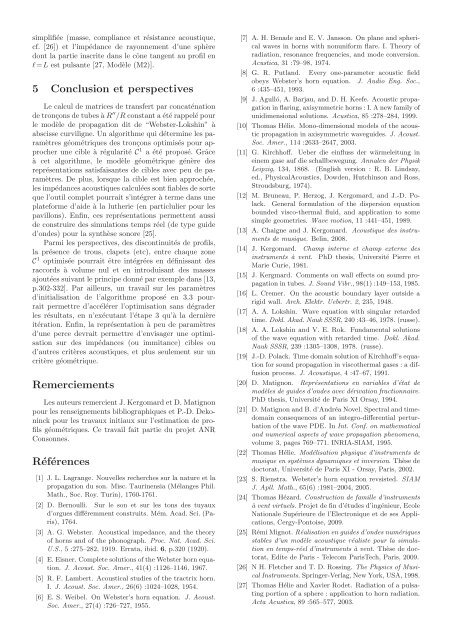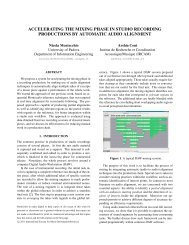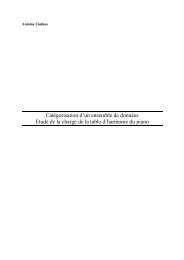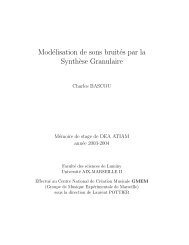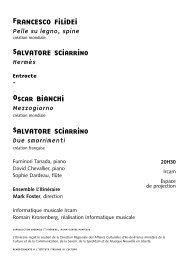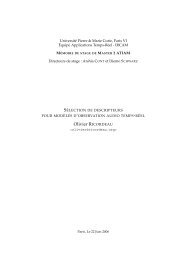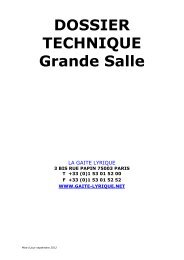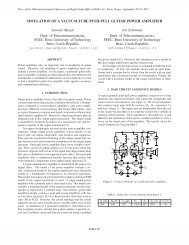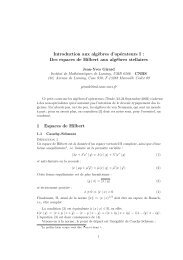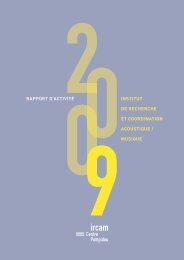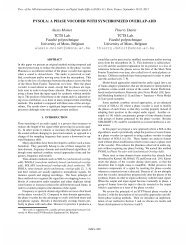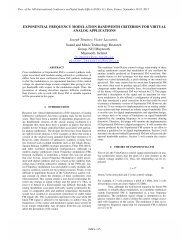Rapport de stage - Master 2 SAR ATIAM - Base des articles ...
Rapport de stage - Master 2 SAR ATIAM - Base des articles ...
Rapport de stage - Master 2 SAR ATIAM - Base des articles ...
- No tags were found...
You also want an ePaper? Increase the reach of your titles
YUMPU automatically turns print PDFs into web optimized ePapers that Google loves.
simplifiée (masse, compliance et résistance acoustique,cf. [26]) et l’impédance <strong>de</strong> rayonnement d’une sphèredont la partie inscrite dans le cône tangent au profil enl=L est pulsante [27, Modèle (M2)].5 Conclusion et perspectivesLe calcul <strong>de</strong> matrices <strong>de</strong> transfert par concaténation<strong>de</strong>tronçons<strong>de</strong>tubesàR ′′ /Rconstantaétérappelépourle modèle <strong>de</strong> propagation dit <strong>de</strong> “Webster-Lokshin” àabscisse curviligne. Un algorithme qui détermine les paramètresgéométriques <strong>de</strong>s tronçons optimisés pour approcherune cible à régularité C 1 a été proposé. Grâceà cet algorithme, le modèle géométrique génère <strong>de</strong>sreprésentations satisfaisantes <strong>de</strong> cibles avec peu <strong>de</strong> paramètres.De plus, lorsque la cible est bien approchée,lesimpédancesacoustiquescalculéessontfiables<strong>de</strong>sorteque l’outil complet pourrait s’intégrer à terme dans uneplateforme d’ai<strong>de</strong> à la lutherie (en particlulier pour lespavillons). Enfin, ces représentations permettent aussi<strong>de</strong> construire <strong>de</strong>s simulations temps réel (<strong>de</strong> type gui<strong>de</strong>d’on<strong>de</strong>s) pour la synthèse sonore [25].Parmi les perspectives, <strong>de</strong>s discontinuités <strong>de</strong> profils,la présence <strong>de</strong> trous, clapets (etc), entre chaque zoneC 1 optimisée pourrait être intégrées en définissant <strong>de</strong>sraccords à volume nul et en introduisant <strong>de</strong>s massesajoutées suivant le principe donné par exemple dans [13,p.302-332]. Par ailleurs, un travail sur les paramètresd’initialisation <strong>de</strong> l’algorithme proposé en 3.3 pourraitpermettre d’accélérer l’optimisation sans dégra<strong>de</strong>rles résultats, en n’exécutant l’étape 3 qu’à la <strong>de</strong>rnièreitération. Enfin, la représentation à peu <strong>de</strong> paramètresd’une perce <strong>de</strong>vrait permettre d’envisager une optimisationsur <strong>de</strong>s impédances (ou immitance) cibles oud’autres critères acoustiques, et plus seulement sur uncritère géométrique.RemerciementsLesauteursremercientJ.Kergomar<strong>de</strong>tD.Matignonpour les renseignements bibliographiques et P.-D. Dekoninckpour les travaux initiaux sur l’estimation <strong>de</strong> profilsgéométriques. Ce travail fait partie du projet ANRConsonnes.Références[1] J. L. Lagrange. Nouvelles recherches sur la nature et lapropagation du son. Misc. Taurinensia (Mélanges Phil.Math., Soc. Roy. Turin), 1760-1761.[2] D. Bernoulli. Sur le son et sur les tons <strong>de</strong>s tuyauxd’orgues différemment construits. Mém. Acad. Sci. (Paris),1764.[3] A. G. Webster. Acoustical impedance, and the theoryof horns and of the phonograph. Proc. Nat. Acad. Sci.U.S., 5 :275–282, 1919. Errata, ibid. 6, p.320 (1920).[4] E.Eisner. CompletesolutionsoftheWebsterhornequation.J. Acoust. Soc. Amer., 41(4) :1126–1146, 1967.[5] R. F. Lambert. Acoustical studies of the tractrix horn.I. J. Acoust. Soc. Amer., 26(6) :1024–1028, 1954.[6] E. S. Weibel. On Webster’s horn equation. J. Acoust.Soc. Amer., 27(4) :726–727, 1955.[7] A. H. Bena<strong>de</strong> and E. V. Jansson. On plane and sphericalwaves in horns with nonuniform flare. I. Theory ofradiation, resonance frequencies, and mo<strong>de</strong> conversion.Acustica, 31 :79–98, 1974.[8] G. R. Putland. Every one-parameter acoustic fieldobeys Webster’s horn equation. J. Audio Eng. Soc.,6 :435–451, 1993.[9] J. Agulló, A. Barjau, and D. H. Keefe. Acoustic propagationinflaring,axisymmetrichorns:I.Anewfamilyofunidimensional solutions. Acustica, 85 :278–284, 1999.[10] Thomas Hélie. Mono-dimensional mo<strong>de</strong>ls of the acousticpropagation in axisymmetric wavegui<strong>de</strong>s. J. Acoust.Soc. Amer., 114 :2633–2647, 2003.[11] G. Kirchhoff. Ueber die einfluss <strong>de</strong>r wärmeleitung ineinem gase auf die schallbewegung. Annalen <strong>de</strong>r PhysikLeipzig, 134, 1868. (English version : R. B. Lindsay,ed., PhysicalAcoustics, Dow<strong>de</strong>n, Hutchinson and Ross,Stroudsburg, 1974).[12] M. Bruneau, P. Herzog, J. Kergomard, and J.-D. Polack.General formulation of the dispersion equationboun<strong>de</strong>d visco-thermal fluid, and application to somesimple geometries. Wave motion, 11 :441–451, 1989.[13] A. Chaigne and J. Kergomard. Acoustique <strong>de</strong>s instruments<strong>de</strong> musique. Belin, 2008.[14] J. Kergomard. Champ interne et champ externe <strong>de</strong>sinstruments à vent. PhD thesis, Université Pierre etMarie Curie, 1981.[15] J. Kergmard. Comments on wall effects on sound propagationin tubes. J. Sound Vibr., 98(1) :149–153, 1985.[16] L. Cremer. On the acoustic boundary layer outsi<strong>de</strong> arigid wall. Arch. Elektr. Uebertr. 2, 235, 1948.[17] A. A. Lokshin. Wave equation with singular retar<strong>de</strong>dtime. Dokl. Akad. Nauk SSSR,240:43–46,1978. (russe).[18] A. A. Lokshin and V. E. Rok. Fundamental solutionsof the wave equation with retar<strong>de</strong>d time. Dokl. Akad.Nauk SSSR, 239 :1305–1308, 1978. (russe).[19] J.-D. Polack. Time domain solution of Kirchhoff’s equationfor sound propagation in viscothermal gases : a diffusionprocess. J. Acoustique, 4 :47–67, 1991.[20] D. Matignon. Représentations en variables d’état <strong>de</strong>modèles <strong>de</strong> gui<strong>de</strong>s d’on<strong>de</strong>s avec dérivation fractionnaire.PhD thesis, Université <strong>de</strong> Paris XI Orsay, 1994.[21] D.Matignon andB.d’AndréaNovel. Spectraland timedomainconsequences of an integro-differential perturbationof the wave PDE. In Int. Conf. on mathematicaland numerical aspects of wave propagation phenomena,volume 3, pages 769–771. INRIA-SIAM, 1995.[22] Thomas Hélie. Modélisation physique d’instruments <strong>de</strong>musique en systèmes dynamiques et inversion. Thèse <strong>de</strong>doctorat, Université <strong>de</strong> Paris XI - Orsay, Paris, 2002.[23] S. Rienstra. Webster’s horn equation revsisted. SIAMJ. Apll. Math., 65(6) :1981–2004, 2005.[24] Thomas Hézard. Construction <strong>de</strong> famille d’instrumentsà vent virtuels. Projet <strong>de</strong> fin d’étu<strong>de</strong>s d’ingénieur, EcoleNationale Supérieure <strong>de</strong> l’Electronique et <strong>de</strong> ses Applications,Cergy-Pontoise, 2009.[25] RémiMignot. Réalisation en gui<strong>de</strong>s d’on<strong>de</strong>s numériquesstables d’un modèle acoustique réaliste pour la simulationen temps-réel d’instruments à vent. Thèse <strong>de</strong> doctorat,Edite <strong>de</strong> Paris - Telecom ParisTech, Paris, 2009.[26] N H. Fletcher and T. D. Rossing. The Physics of MusicalInstruments. Springer-Verlag,NewYork,USA,1998.[27] Thomas Hélie and Xavier Ro<strong>de</strong>t. Radiation of a pulsatingportion of a sphere : application to horn radiation.Acta Acustica, 89 :565–577, 2003.


